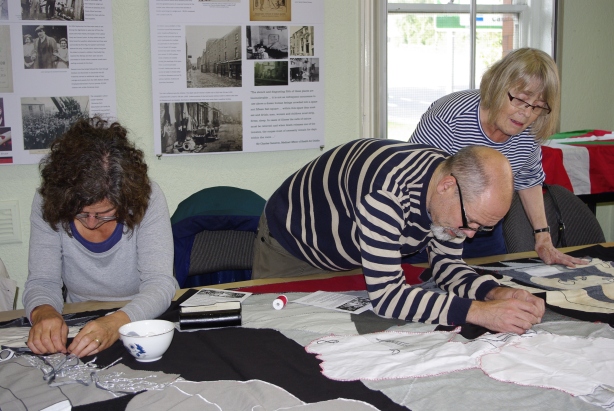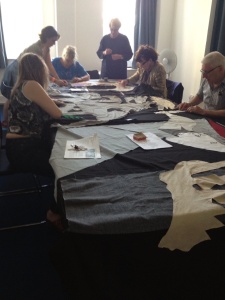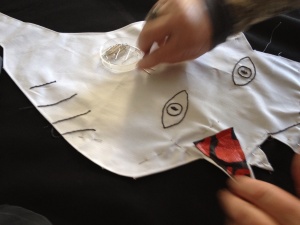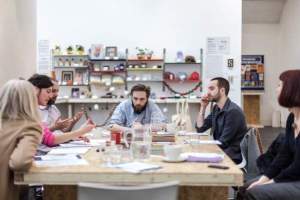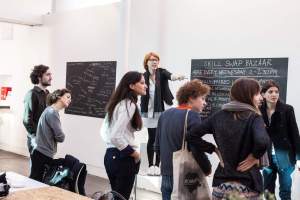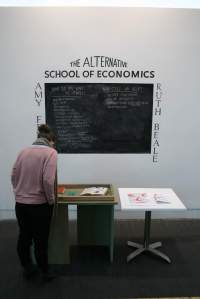On 26 April, the anniversary of the aerial bombing of the town of Gernika in 1937 which led Picasso to paint his sombrely magnificent Guernica, we published a blog posting introducing the Re-Making Guernica project, the inspiration of a group of academics, artists and makers at the University of Brighton who invited activists to join them in creating an art of protest against fascism. Now read on…
What do you think an artist is? An imbecile who has only his eyes if he’s a painter, or ears if he’s a musician, or a lyre at every level of his heart if he’s a poet, or even, if he’s a boxer, just his muscles? On the contrary, he’s at the same time a political being, constantly alive to heartrending, fiery, or happy events, to which he responds in every way. How would it be possible to feel no interest in other people and by virtue of an ivory indifference to detach yourself from the life which they copiously bring you? No, painting is not done to decorate apartments. It is an instrument of war for attack and defence against the enemy.
Pablo Picasso: From an interview with Simone Téry, 1945
The excitement, focus and engagement expressed by Picasso in his words above are at the heart of our project, Re-Making Guernica.
We all share a commitment to the uses of art in challenging perceptions, so that we can begin to see things in new ways, waking up lazy ways of seeing, making us aware of habits and of our tendency to stereotype, unpacking texts so as to reveal new meanings.
We also share a passionate interest in the uses of art in political struggle. To name just a few examples, Jenny made many striking banners at Greenham Common Women’s Peace Camp, enjoying the ways in which they carry a message and become a permanent expression of history. Pete has curated exhibitions for socially didactic purposes. Jill has spent her life working on projects which foreground women, whose artefacts and events have often been written out of history. Megha’s art practice uses sound, painting and sculpture to explore Indian women’s migration post-1990s in the era of globalisation. Louise worked on a project to preserve parts of Long Kesh prison and curated an exhibition of materials created as part of anti-Guantanamo campaign work. Maude was at school in Paris in 1968 and worked alongside students who were making posters, using cartoons, words and graphic forms to rally support, interrogate assumptions and create unities. All of us have taken part in political actions where the creation of a banner, or a placard, or items of clothing or badges have been part of that action, dramatically enacting or expressing it while also inviting engagement and dialogue.
An unwavering commitment to resisting injustice unites us; many of us have been active in the peace movement and anti-fascist actions for several decades. Several of us volunteer for organisations which support refugees and asylum seekers who have no recourse to public funds, or who are enduring indefinite detention in UKBA Removal Centres, frequently with no other contact with the outside world Others visit Palestine to support those who endure daily trauma and indignity and whose livelihoods have been brutally stripped away. Some of us have felt keenly the ways in which as women we have a different experience of war: we produce sons; we most frequently experience rape as a weapon of war; we are victims of trafficking – and we campaign for organisations to bring about an end to this.
In a time of austerity, we might remember our mothers or grandmothers making do and mending. However we also recall the ways that fascists grow in numbers at times when mainstream politicians seek to blame economic hardship and social dislocation – which are the results of the political system over which they preside – upon groups that already endure forms of political exclusion: refugees, asylum seekers and migrants.
We all see the collaborative process of making as a powerful antidote to the destructive powers of war and violent political systems. Sitting down together to listen to one another, giving one another space to be heard; sharing common experiences or perceptions; muddling through the process of sewing itself, which drives some of us mad and which some of us find deeply boring; feeling upon us the beady eyes and critical gazes of our mothers or grandmothers – all so much more adept and deft with needle and thread than most of us will ever be; deciding upon stitches and showing one another how to sew them; deciding upon fabrics; talking about pieces of cloth which we have saved from our families’ pasts; showing one another little needle cases made for our mother in our childhoods; noting the humble simplicity of the tools used for sewing – their universality and their power in clothing and sheltering the world throughout history. All of these experiences have been creative and empowering for us. They have also shown us that it doesn’t matter how rubbish at sewing we might individually feel we are: commitment to the process and to Picasso’s work and its messages, which we are re-making, are what count more than counting perfect stitches.
Maude Casey – Re-Making Guernica project
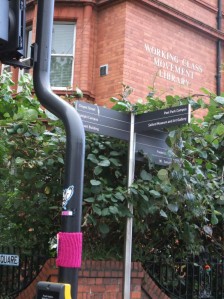
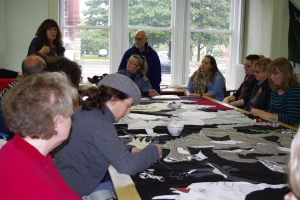 And then people set to sewing! Some were skilled, some less confident but still eager to play their part in such a lovely collaborative venture.
And then people set to sewing! Some were skilled, some less confident but still eager to play their part in such a lovely collaborative venture.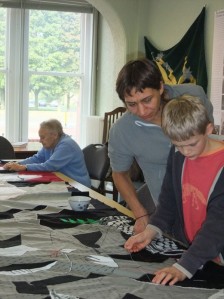 Much tea was drunk, many stories were shared – including Adrine Middleton’s tale of how she’d seen the original Guernica when the vast painting travelled, extraordinarily, to Manchester in 1939.
Much tea was drunk, many stories were shared – including Adrine Middleton’s tale of how she’d seen the original Guernica when the vast painting travelled, extraordinarily, to Manchester in 1939.